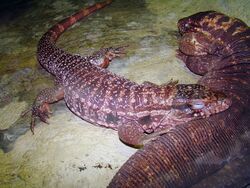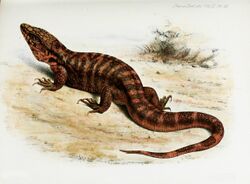Biology:Red tegu
| Red tegu | |
|---|---|

| |
| Scientific classification | |
| Domain: | Eukaryota |
| Kingdom: | Animalia |
| Phylum: | Chordata |
| Class: | Reptilia |
| Order: | Squamata |
| Family: | Teiidae |
| Genus: | Salvator |
| Species: | S. rufescens
|
| Binomial name | |
| Salvator rufescens (Günther, 1871)
| |
| Synonyms | |
|
Tupinambis rufescens See text | |
The red tegu (Salvator rufescens) is found in western Argentina , Bolivia and Paraguay.
Appearance
As hatchlings, most red tegus display little, if any, red coloration. They are typically brownish-green with black strips across their width and several broken white stripes down their length. They develop red coloration as they mature; males are usually brighter than females.[1][2] Adult females can reach 91 cm (just under 3 ft) in length. Males are significantly larger, reaching up to 140 cm (4.5 ft) and developing large jowls.
Growth
The red tegu grows rapidly, typically reaching maturity in two to three years. It is not uncommon for well-fed juveniles to experience growth spurts of more than an inch per week.
Diet
The red tegu is a very opportunistic feeder. Wild specimens will eat a variety of plant and animal matter: fruits, vegetables, insects, rodents, birds, and fish. Red tegus raised in captivity will often be more picky eaters, especially as juveniles, and may prefer a diet of mostly meat.
See also
References
- ↑ Bartlett, R., & Bartlett, P. (1996). Monitors, Tegus, and Related Lizards. Barron’s Educational Series.
- ↑ Pianka, E. R. (2006). Lizards: Windows to the Evolution of Diversity. University of California Press.
Wikidata ☰ Q18460489 entry


